Africa is unlike any other place in the world you’ve ever visited. This vast area, which includes 54 countries and 144 Unesco World Heritage Sites, offers visitors a diverse range of cultures, fascinating history, beautiful natural landscapes, incredible wildlife, and some of the world’s most remarkable African landmarks. These prominent naturals and artificial landmarks in Africa provide an insight into both the well-known and unknown stories of Africa.
Here are a few of the top tourist sites and places in Africa that are well worth visiting to give you some ideas for your next vacation. Let’s take a closer look.
Table of Contents
1. The Great Pyramids of Giza, Egypt

There is a mix of beautiful natural scenery and ancient monuments made by people. Africa is so unique because it blends the lives of people and animals so well and has something for every kind of traveler. Whether you’re an adventurous explorer, an animal lover, an outdoor enthusiast, a history buff, a beach bum, or a city explorer, you’ll find something for yourself.
The Great Pyramids of Giza and the Sphinx are Africa’s oldest artificial tourist attractions. They are also the only one of the ancient Seven Wonders of the World that is still standing. The Great Pyramid was the tallest artificial structure on Earth for a long time. There are too many praises and qualities to count.

Yet, the Pyramids of Giza are still a mystery. Scientists haven’t been able to come up with a reasonable explanation for how these vast buildings were made. But these landmarks show us important things about a long-ago civilization. The shape of the pyramids was made to look like the sun’s rays between heaven and Earth, and the inside walls were often covered with sacred art, inscriptions, and carvings.
The Pyramids of Giza are over 4,500 years old and are so big that they can be seen from space. They were built as temples for the gods and tombs for the pharaohs. They were filled with everything the Egyptians thought would be needed in the next world.
The pyramid of Khufu stands at 146 meters and is the oldest and most significant of these pyramids (481 feet).
Other notable things about the Great Pyramid include being built around 2650 BC, with each of its four sides facing a cardinal direction. The monument is made up of 2.3 million blocks of granite and limestone. Each block weighs 7 tons, giving the memorial a total weight of 6,840,000 tons.
Archaeologists say that it was the tallest building on Earth when it was finished, and it stayed that way for more than 3,800 years. There are three rooms inside: the King’s room, the Queen’s room, and an unfinished room in the basement.

>> Are you going to Egypt? Before you go, you must read these essential travel tips.
There are thousands of monuments from the Old Kingdom of Egypt in modern-day Egypt, but the Sphinx and the Great Pyramids of Giza are the most famous and well-known. This unique tourist attraction is close to the center of Cairo, so you can go there on your own or with a guide. It is a well-known landmark in Africa, and it is still one of the most fascinating ancient buildings in the world. To believe it, you have to see it for yourself.
2. Mount Kilimanjaro, Tanzania
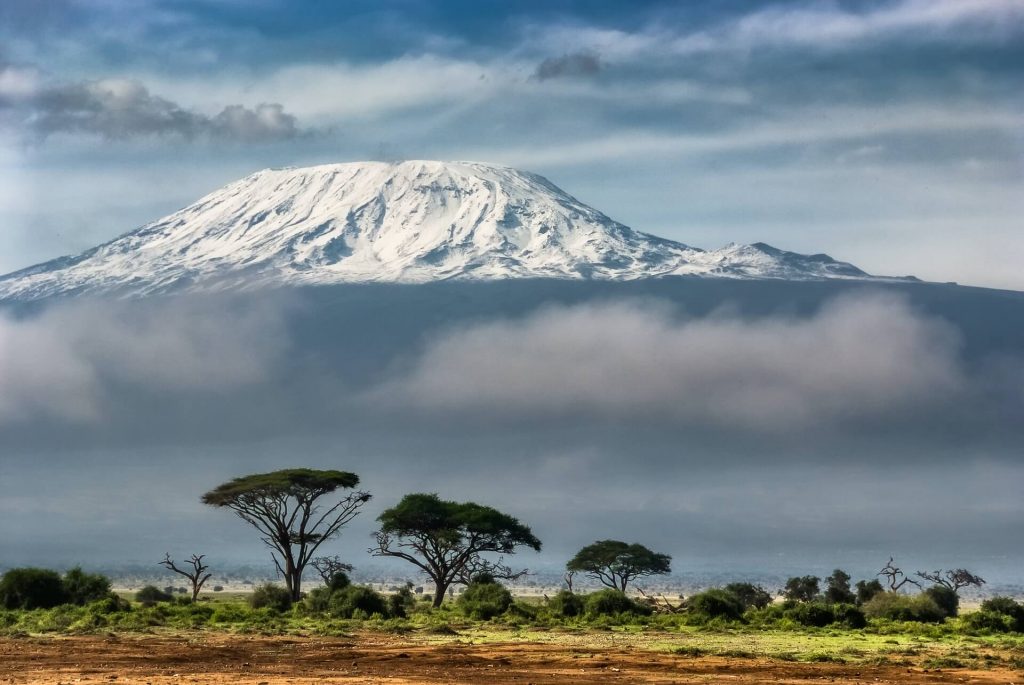
Mount Kilimanjaro, the highest mountain in Africa, has to be on any list of important places in Africa. It is also the highest freestanding mountain globally, with a snow-covered peak that rises 5,895 meters (19,341 feet) above sea level.
Kilimanjaro is a dormant volcano in northern Tanzania with three volcanic cones: Kibo, Shira, and Mawenzi. The highest point is Uhuru Peak, located on the crater rim of Mount Kibo. The Furtwangler Glacier is at the top of Mount Kilimanjaro. The Furtwangler Glacier is just a tiny piece of what used to be a massive ice cap on top. It will probably all melt away over the next couple of years.

Kilimanjaro is also one of Africa’s most well-known places. Climbing Kili and getting to the top of Africa has become a popular tourist attraction and “bucket list” item for travelers who like to try new things. Outdoor lovers and mountain climbers worldwide want to say they’ve stood on top of the world’s tallest freestanding landmark. It is also popular because it is thought to be the easiest of the seven summits. After all, you don’t need any technical climbing skills to do it.
Kilimanjaro is not a walk in the park, though, and you do need to be fit and have a lot of stamina to climb it. The climb is also not too expensive, and it doesn’t take a lot of time.

Kilimanjaro is also famous because of its beautiful and varied scenery, both on the mountain and in the surrounding area. As you go up the hill, the site has many different habitats and environments. Kilimanjaro National Park protects the plains, home to elephants, antelope, buffalo, and many other animals and birds. Most of the foothills are covered with lush tropical montane forests. After that comes the cloud forest, the alpine desert, and a sparkling view of glaciers, snow, and ice.
Mount Kilimanjaro is a famous landmark worldwide and a symbol of Africa. Walking in its shade, surrounded by the land’s beauty, is a unique experience. When you stand on the roof of Africa, you get a special feeling. This is a great experience to have.
3. Table Mountain, South Africa

Table Mountain is the most photographed and famous landmark in the country. It stands tall over Cape Town and Table Bay, and The mountain gets its name from the shape of its flat top, which looks like a table. It is 1086 m (3563 ft) above sea level. Table Mountain is thought to be one of the world’s oldest mountains because its rocks are more than 60 million years old. The mountains Lion’s Head and Devil’s Peak are on either side of the vast plateau.

The highest point on Table Mountain is Maclear’s Beacon, which is on the eastern edge of the plateau and stands 3,563 feet above sea level.
This popular tourist spot in Africa has a lot of things to do and a beautiful view of the city below. There are many things to do, like hiking, camping, and abseiling. You can also take a 5-minute cable car ride to the top of the mountain.

One of the most biodiverse places globally has hundreds of trails and steep, rocky paths that lead to it. Over 2000 different plants can only be found in this floral kingdom. Keep an eye out for the Rock Hyrax dassie, the Chacma Baboon, the Table Mountain ghost frog, and the many porcupines, tortoises, snakes, and lizards in this area.
Table Mountain is still one of the best places to see in Africa. Its beauty and wildness make it a place that should not be missed.
A few more famous places in South Africa are the Blyde River Canyon, Kruger National Park, Drakensberg, Cradle of Humankind, and Robben Island.
4. Victoria Falls, Zambia, Zimbabwe

The Victoria Falls, one of the Seven Natural Wonders of the World, is known for being the world’s largest waterfall, not just on the African continent. This magnificent natural wonder forms the border between Zambia and Zimbabwe on the Zambezi River in Southern Africa.
With an average flow rate of 1 million liters per second and a width of 1,708 meters (5,604 feet), and a height of 108 meters (355 feet), Victoria Falls is the world’s most significant body of falling water.
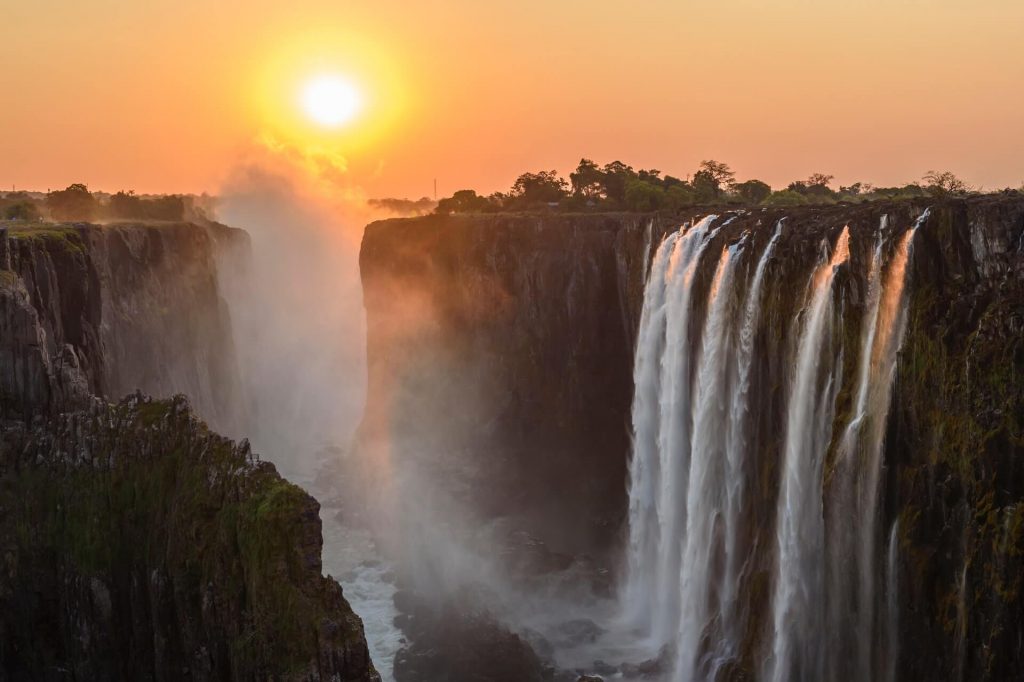
The falls, one of the most beautiful in the world and a well-known African icon, were designated as a UNESCO World Heritage Site in 1989. The Zambezi River plunges over a cliff and into the Boiling Pot before running down a series of gorges, giving it the nickname Mosi-oa-Tunya, which means “the smoke that thunders.” This natural wonder may be heard, seen, and felt from kilometers away.
The Mosi-oa-Tunya National Park in Zambia and the Victoria Falls and Zambezi National Parks in Zimbabwe preserve Victoria Falls. The big waterfall can be seen from either country or, even better, from both sides in one day. Livingstone, Zambia, and Victoria Falls, Zimbabwe, are the nearest tourist towns to the falls. Closer vistas on the Zambian side provide a stronger sense of the falls’ force and enormity as you get soaked. The Zimbabwean side is further away for better images and overall perspective.

This prominent natural landmark location is also regarded as Africa’s adventure capital with a wealth of adrenaline-inducing activities. The most popular is the 111-meter (364-foot) bungee leap from the bridge above the falls into the canyon below. Microlight flights, animal safaris, whitewater rafting, zip-lining, and other activities are available. You can even swim at Devil’s Pool during the dry season, a natural rock pool located right at the edge of the Zambian side of the falls.
Victoria Falls, the world’s widest single-sheet waterfall and a must-see African tourist attraction, is an awe-inspiring spectacle to see.
Great Zimbabwe, Lake Kariba, Hwange, and Mana Pools National Parks are among the region’s other attractions.
5. The Pyramids of Meroë, Sudan

Deep in the desert of eastern Sudan is a fascinating collection of almost 200 ancient pyramids. Once, these ancient pyramids of Meroë were part of a thriving and wealthy civilization. Today, this faraway place in Africa is the most important archaeological site in Sudan and the most impressive tourist attraction in the country.
Meroë was a famous and wealthy city in the ancient kingdom of Kush. It was founded in the first millennium BCE. Around 750 BCE, it became the administrative center of the domain. Later, it was named the kingdom’s capital.
The rulers of the ancient Kushite kingdoms built the pyramids, and many of them were tombs for the Kings and Queens who ruled the area for more than 900 years. The ruins are in the middle of the Sudanese desert, about 3 hours from Khartoum, the country’s capital. They are near the Nile River and cover an area of over one square mile. The ruins were first found in the 1800s. At the beginning of the 20th century, excavations brought to light a fascinating collection of pyramids, palaces, and temples. Meroë was added to the list of World Heritage sites by UNESCO in 2003.
The Pyramids of Meroë, built between 2,700 and 2,300 years ago, are considered Nubian pyramids. They are smaller than the ones in Egypt, their bases are narrow, and their sides are sharp.
Even though Sudan isn’t on the bucket lists of many travelers, the Meroë pyramids are high on my list of beautiful places to visit in Africa. What do you think?
6. Okavango Delta, Botswana
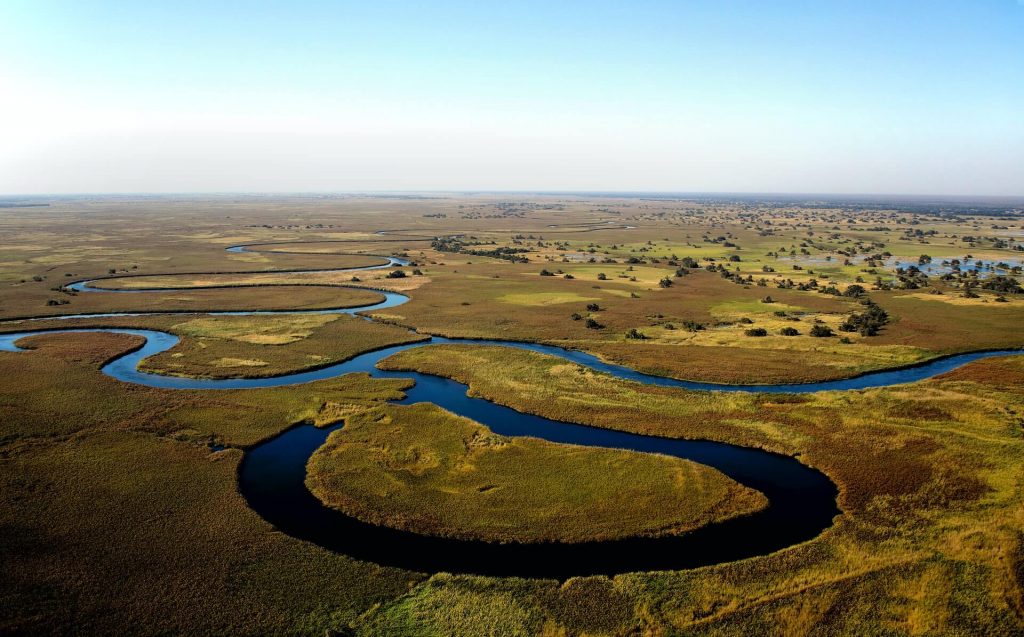
The Okavango Delta in northwestern Botswana is the largest inland delta globally. It is also one of the most well-known places in Africa. This beautiful oasis is made when the Okavango River flows into the Kalahari Desert. It is part of the Great East African Rift Valley. This floods the savannah around it, making a complicated network of waterways and a dynamic ecosystem that changes and stretches over 15,000 kilometers.
The Okavango Delta is different from other river deltas because the Okavango River empties onto land instead of the ocean. This delta also called the Jewel of the Kalahari, is in the northern part of Botswana in the Kalahari desert. It is about 15,000 square kilometers in size.

The Okavango is a river that flows only during the summer months of December through March when it rains in the Angolan highlands. From March to June, water flows over into flood plains, making the delta almost three times as big as before.

The Okavango Delta is a popular safari spot in Africa because it is a safe place for many different species. Because there are so many different kinds of animals there, it is one of the best places in Africa to see animals in their natural habitat. Keep an eye out for animals like cheetahs, African elephants, black rhinos, lions, African wild dogs, buffalo, hippopotamuses, and crocodiles, to name a few. Here, you can also fish, watch birds, go on boat safaris, and learn about the culture of nearby villages.
The Okavango Delta deserves to be on the Seven Natural Wonders of Africa Landmarks list because of all of these things. Chobe National Park is another place in Botswana that you must see.
7. Rock-hewn Churches of Lalibela, Ethiopia
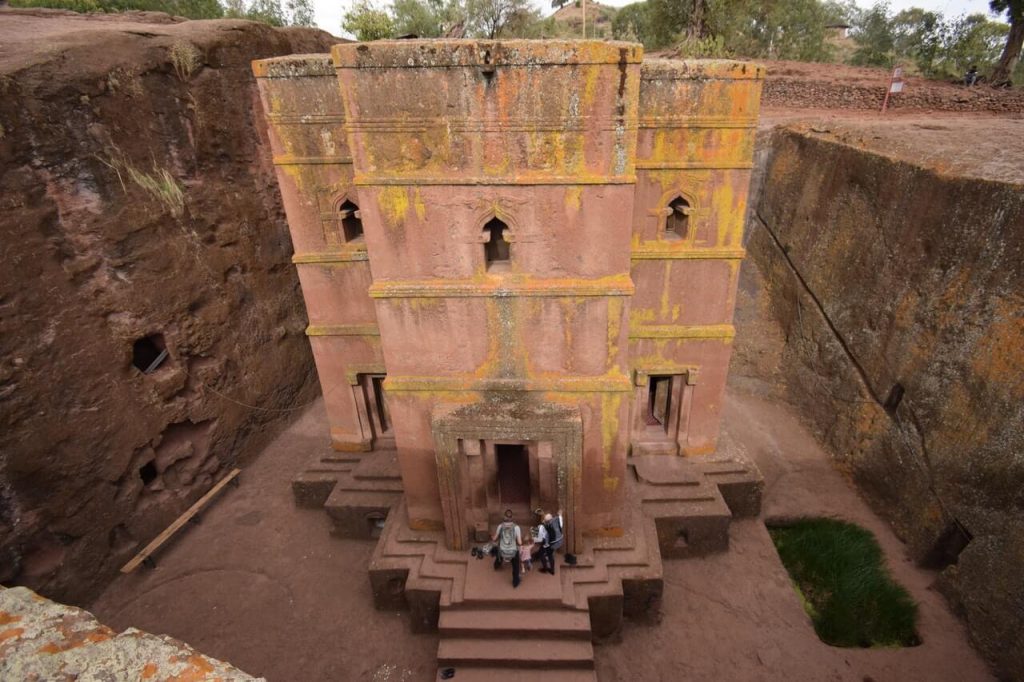
The eleven rock-hewn churches in the small town of Lalibela in north-central Ethiopia make it one of the most unique and mysterious places in Africa. These beautiful churches are one-of-a-kind because they were not built in the usual way. Instead, they were carved and cut out of one piece of living rock.
The churches were built between the 7th and 13th centuries, and since the 12th century, Coptic Christians have been making pilgrimages there. Even though they were built hundreds of years ago, these artificial sites in Africa still draw more than 100,000 Orthodox Christians on expeditions, especially on holy days.

Lalibela, the King of the Zagwe people, ordered the building of 11 monolithic churches as part of his plan to make a new Jerusalem his capital. This was done because old Jerusalem had been taken over. People think that the layout and names are a representation of Jerusalem.
Each church was cut out of a single piece of solid rock. This was done to show spiritual unity and humility and was seen as a world wonder. Elegant buildings are connected by underground passages and tunnels that twist and turn. The 11 churches are split into two main groups, with the House of Medhane Alem, the House of Golgotha, and the House of Mariam being the most famous.
These religious buildings in Africa are some of the world’s most impressive historical sites. They are also the most popular place to visit in the country. The Danakil Depression, the Rift Valley, and the Blue Nile Falls are essential places in Ethiopia.
8. Sahara Desert of North Africa

The Sahara Desert is the largest hot desert globally, and It is 9.2 million km2 (3.5 million square miles) in size. It takes up 8 percent of all the land on the planet. This essential top Africa landmark stretches across 11 countries in northern Africa: Egypt, Morocco, Western Sahara, Mauritania, Algeria, Libya, Chad, Mali, Niger, Sudan, and Tunisia.
More than 11,000 years ago, the Sahara was a fertile land with crops growing there. But when the tilt of the Earth’s orbit changed, the land started to dry up and become a desert. In the Sahara, there are not only dunes but also oasis towns, mountains, and even volcanoes that are no longer active.

The name Sahara comes from the Arabic words ar and ar, which means “sand” and “sands.” This is one of the hottest places in Africa and Earth because the sun is up high, it doesn’t rain much, and there isn’t much humidity.
Even though the Sahara is already huge, it has grown by 10% in the last 100 years. This is primarily because of natural changes in the climate and global warming.
This one-of-a-kind place in Africa is a must-see. Travelers who like to try new things are drawn to the quiet, the beauty, the night sky full of stars, and the bedouin vibes. Keep an eye out for camels, oryx, cobras, Barbary sheep, and dama gazelle, to name a few of the animals that live in this desert landmark.
9. Avenue of the Baobabs, Madagascar

The Avenue of the Baobabs is a unique place globally and a well-known landmark in Africa; It is on the island of Madagascar. Madagascar is the largest island in Africa and the fourth largest globally. It is in the Indian Ocean, near the southeast coast of Africa. Since it has been alone for more than 80 million years, many of its animals and plants can only be found there.
The Avenue of the Baobabs is a road in the western part of Madagascar that is lined with beautiful Baobab trees. This dirt road is a national highway (Route Nationale N8) between Morondava and Belon’i Tsiribihina in the Menabe region, about 660 kilometers from the capital, Antananarivo.

The Baobab trees are only found in Madagascar. They are a species called Adansonia Grandidieri, and they are about 2,800 years old. These giant trees can grow up to 30 meters (100 feet) tall and have a diameter of 11 meters (35 feet) and a circumference of 50 meters (160 feet).
The beautiful road has become a significant tourist spot because it is one of the most famous places in Africa. People from all over the world come to see this unique African landscape. It is only 260 meters long, but the site of 25 giant trees that are more than 30 meters (98 feet) tall makes for a dramatic scene.

The Alley of the Baobabs is the focus of local conservation efforts, and since 2007, it has been protected as the island’s first national monument in Africa. The local name for the Baobab tree is Renala, which means “mother of the forest.” It’s also called the “tree of life” because it can be used for many things. It can be used to make clothing and rope and a place to live, food, water, and medicine made from plants.
The baobab tree is in danger of dying out, so if you want to see one, you should go now while you still can. The best times to visit this landmark are at sunrise or sunset, when the colors and shadows are at their most beautiful. While you’re here, don’t miss Baobab Amoureux, which is also well-known but not as well-known. Here, two Baobab trees are twisted together. These are often called the “Baobabs of Love.”
10. The Nile River

With a length of 6,852 km (4,258 miles), the Nile River is not just the longest river in Africa but the whole world. The river starts in northeast Africa and flows through eleven countries north to the Mediterranean Sea.
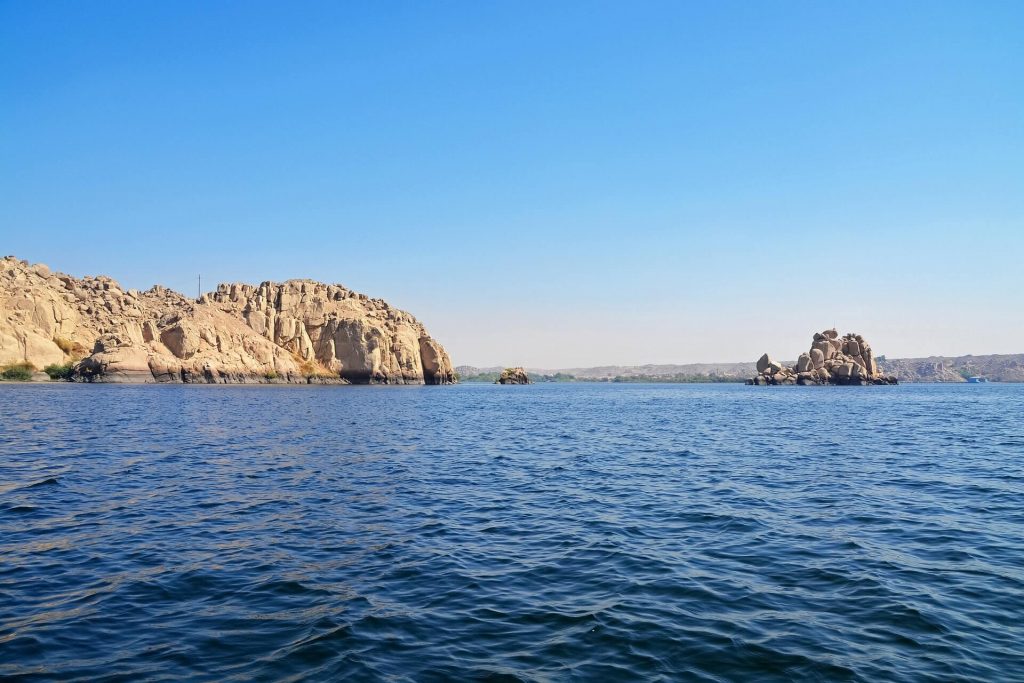
The Nile is more than 30 million years old. It flows through 11 countries at an average of 3.1 million liters (680,000 gallons) per second.
The Nile starts south of the equator in Burundi, and it has two sources: the Blue Nile comes from Lake Tana in Ethiopia, and the White Nile comes from Lake Victoria in Tanzania. It takes about three months for the water to travel the entire river until it empties into the Mediterranean.

Luxury cruises are the most popular way to see and travel along with this important landmark in Africa. Many of these luxury cruise ships and yachts have planned shore excursions that let you see the major sights along the way, such as famous tombs, temples, pyramids, and the Aswan Dam. Popular things to do along the Nile are white water rafting, jet boating, swimming, fishing, and kayaking.


